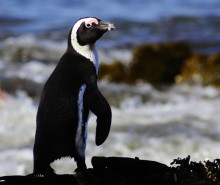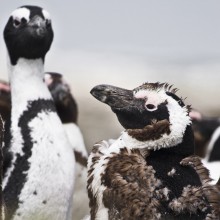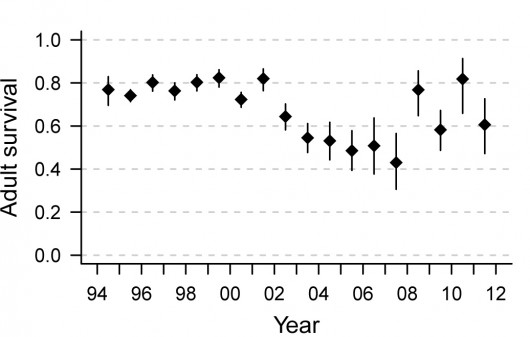 The African Penguin
population is in freefall, with adult survival rates over the last
decade desperately low. Urgent management action is required to secure
both the prey requirements and future of one of Africa’s most
charismatic seabirds.
The African Penguin
population is in freefall, with adult survival rates over the last
decade desperately low. Urgent management action is required to secure
both the prey requirements and future of one of Africa’s most
charismatic seabirds.
Richard B SherleyAnimal Demography Unit and Marine Research Institute, University of Cape Town, South Africa
Linked IBIS paper
Age-specific survival and movement among major African Penguin Spheniscus demersus colonies. Sherley, R.B., Abadi, F., Ludynia, K., Barham, B.J., Clark, A.E. & Altwegg, R.
Globally, seabirds are in trouble. With 28% of species listed as globally threatened by the IUCN, no other similarly sized group of birds has a poorer conservation status. Seabirds are susceptible to a wide range of anthropogenic pressures, but some of the most substantial threats they face stem from the deterioration of their marine environment through unsustainable fishing practices and climate change.
Penguins may be particularly sensitive to changes in the oceans that they inhabit compared to flying seabirds, because they must swim to find their food (Boersma 2008). The African Penguin Spheniscus demersus, endemic to South Africa and Namibia, has decreased by more than 90% since the 1930s. In South Africa numbers have dropped by more than 10% a year since 2004, resulting in the species being up-listed to Endangered in 2010. Off the Namibian coast, heavy commercial fishing collapsed the stocks of sardine Sardinops sagax and anchovy Engraulis encrasicolus (the penguins’ main prey) in the 1960s and 1970s. The stocks have never recovered and today penguins in Namibia rely on a diet of junk food (Ludynia et al. 2010).
In South Africa, large-scale changes in the marine environment (possibly linked to global climate change) have caused a change in the spawning grounds of sardine and anchovy. These fish now mostly spawn further east than they did two decades ago and are out of reach of penguin colonies on South Africa’s West Coast for much of the year. However, because many of the fish canning factories are also on the West Coast and fishing vessels, like birds, are limited in how far they can go to find fish, the result has been relatively heavy fishing pressure in areas where the fish have become scarce. This is particularly true for adult sardine, a valuable commercial fish and a key source of energy for African penguins when they need to build up body condition to breed each year (Sherley et al. 2013a).

Seabirds will often respond to a scarcity of food by skipping or abandoning breeding, opting not to re-lay after losing clutches of eggs, or reducing the amount of food brought to the chicks leading to slow growth, poor chick condition and mortality through starvation. African penguins have shown all of these responses in recent years. Over time, these behavioural responses can lead to population declines through poor breeding success and juvenile survival, but they usually allow adult seabirds to buffer periods of poor food availability. Although their body condition may fall below a critical threshold needed for breeding, in long-lived animals like seabirds, adult survival is rarely compromised except in cases of extreme food shortage.
Our work, published this week in IBIS (Sherley et al. 2014), demonstrates that this is exactly what has happened with African penguins breeding in South Africa’s Western Cape. Over the course of our study period (1994/95 to 2011/12), we noted substantial decreases in adult survival as the availability of adult sardine decreased on the West Coast. At what was formerly the largest colony, Dassen Island, adult survival dropped from around 80% per year in the late 1990s and early 2000s to a low of 43% in 2007/08 (Figure 1) and a similar decline was noted at nearby Robben Island. During this period, heavy fishing pressure persisted in areas with low fish abundance because of the distribution of land-based processing plants, leading to sardine exploitation rates between 2004 and 2007 which were more than double the long-term average.
 Figure 1.
Time-dependent survival estimates (and 95% confidence intervals) for
adult African Penguins from Dassen Island, Western Cape between 1994/95
and 2011/12.
Figure 1.
Time-dependent survival estimates (and 95% confidence intervals) for
adult African Penguins from Dassen Island, Western Cape between 1994/95
and 2011/12.These poor adult survival rates indicate that the population is unsustainable and are, in a large part, the reason for the recent dramatic decline in the number of African penguins breeding in South Africa. Ecologists working in the country have been recommending spatial management of the fishery to offset losses of penguins since 2006 and, in response to the species’ worsening conservation status, the government’s fisheries department has begun to investigate the potential benefits to penguins of spatial closures. Experimental small-scale fishing exclusions have been implemented around several breeding colonies, in the hope that this may take some pressure off of the penguins during the breeding season, allowing them to balance their energy budgets more easily.
However, despite the closures having reduced the energetic costs of foraging at one colony (Pichegru et al. 2012) and encouraging results from a modelling study (Weller et al. 2014), evidence for demographic benefits has been scarce and the experimental closures may be removed at the end of 2014. Even if they remain in place, recent biologging studies have demonstrated that non-breeding and juvenile African penguins travel over hundreds of kilometres and feed in areas far from their breeding colonies (e.g. Sherley et al. 2013b). Thus, these closures as a stand-alone management action will not be adequate to reverse the rapid decline in Africa’s only endemic penguin. Rather, a suite of management measures is encouraged to mitigate the multiple factors contributing to the worrying decline of African penguins (Weller et al. 2014, Ludynia et al. 2014). Impacts on adult survival, such as those noted in our study, make it essential that government organizations rapidly implement effective fisheries management actions over large spatial scales to ensure food security for marine top predators.
References
Boersma, P. 2008. Penguins as marine sentinels. Bioscience 58: 597–607. ViewLudynia, K., Roux, J.-P., Jones, R., Kemper, J. & Underhill, L.G. 2010. Surviving off junk: low-energy prey dominates the diet of African penguins Spheniscus demersus at Mercury Island, Namibia, between 1996 and 2009. African Journal of Marine Science 32: 563–572. View
Ludynia, K., Waller, L.J., Sherley, R.B., Abadi, F., Galada, Y., Geldenhuys, D., Crawford, R.J.M., Shannon, L.J. & Jarre, A. 2014. Processes influencing the population dynamics and conservation of African penguins on Dyer Island, South Africa. African Journal of Marine Science 36: 253–267. View
Pichegru, L., Ryan, P.G., van Eeden, R., Reid, T., Gremillet, D. & Wanless, R. Industrial fishing, no-take zones and endangered penguins. Biological Conservation 156: 117–125. View
Sherley, R.B., Underhill, L.G., Barham, B.J., Barham, P.J., Coetzee, J.C., Crawford, R.J.M., Dyer, B.M., Leshoro, T.M. & Upfold L. 2013a. Influence of local and regional prey availability on breeding performance of African penguins Spheniscus demersus. Marine Ecology Progress Series 473: 291–301. View
Sherley, R.B., Ludynia, K., Lamont, T., Roux, J.-P., Crawford, R.J.M. & Underhill, L.G. 2013b. The initial journey of an endangered penguin: implications for seabird conservation. Endangered Species Research 21: 89–95. View
Sherley, R.B., Abadi, F., Ludynia, K., Barham, B.J., Clark, A.E. & Altwegg, R. 2014. Age-specific survival and movement among major African Penguin Spheniscus demersus colonies. Ibis. DOI: 10.1111/ibi.12189.
Weller, F., Cecchini, L.-A., Shannon, L., Sherley, R.B., Crawford, R.J.M., Altwegg, R., Scott, L., Stewart, T. & Jarre A. 2014. A system dynamics approach to modelling multiple drivers of the African penguin population on Robben Island, South Africa. Ecological Modelling 277: 38–56. View

About the author
Richard Sherley is a Postdoctoral Researcher with the Animal Demography Unit and Marine Research Institute at the University of Cape Town. He has conducted research on seabirds in southern Africa for the last seven years, focusing on understanding how their productivity, survival and dispersal are influenced by the anthropogenic and environmental changes occurring in their marine ecosystem. In particular, he is interested in research that applies ecological theory to create tangible conservation benefits and in understanding how the conditions that animals experience early in life may influence later fitness and impact on population dynamics.View full profile
Photo images
TOP: African Penguin © Richard SherleyBOTTOM: Moulting African Penguin © Davide Gaglio davygaglio.wix.com
source






 King penguins.
King penguins.















